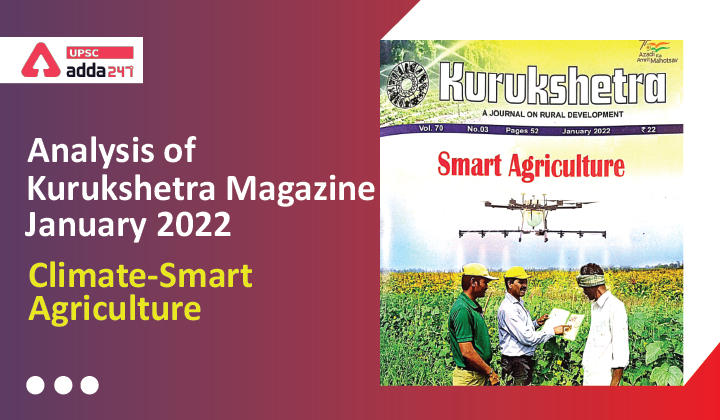Table of Contents
Relevance
”GS 3: Government Policies & Interventions, Agricultural Resources”
Introduction
• Overall, the countrywide decline in major crop yields due to climate change effects between 2010 and 2039 could be as high as 9 per cent, worsening further with time.
• The estimated impacts of both historical and future climate change on cereal crop yields in different regions indicate that such yield loss can be up to 35 per cent for rice, 20 per cent for wheat, 50 per cent for sorghum, 13 per cent for barley, and 60 per cent for maize depending on the location, future climate scenarios and projected year.
• Higher temperature eventually reduces yields of desirable crops while encouraging weed and pest proliferation. ln human terms, this could make large swathes of small farmers’ landholdings unviable.
What is Climate-Smart Agriculture (CSA)?
- The Food and Agriculture Organisation has developed the concept of Climate-Smart Agriculture, which was presented at the Hague Conference on Agriculture, Food Security and Climate Change in 2010.
- The FAO describes the concept as follows:
“Climate-smart agriculture (CSA) is an approach that helps guide actions to transform agri-food systems towards green and climate-resilient practices. It aims to tackle three main objectives: sustainably increasing agricultural productivity and incomes; adapting and building resilience to climate change; and reducing and/or removing greenhouse gas emissions, where possible.”
3 Pillars of CSA Productivity
- Sustainable Intensification
- Adaptation
- Mitigation
Characteristics of CSA
- CSA differs from conventional agricultural paradigms due to the following:
- CSA attempts to address climate change’s causes and effects: Contrary to conventional agricultural development, CSA systematically integrates climate change into the planning and development of sustainable agricultural systems.
- CSA integrates multiple goals and manages multiple trade-offs: CSA’s three primary pillars are interrelated concerns- increased productivity, enhanced resilience and reduced emissions.
- CSA maintains ecosystem services: Ecosystems provide the agricultural sector with a number of ‘unpaid’ services-clean natural water, materials, food, sunlight, etc. CSA attempts to ensure the sustainability of these services, preventing their degradation.
- CSA has multiple entry points at different levels: CSA is not a rigid set of particular practices, technologies, or methodologies- it is only a concept amenable to adaptation.
- CSA has context-specificity: What is an appropriate sustainable practice in a marshland may prove inappropriate in an arid land.
- CSA involves the marginalised: The vulnerable and marginalised, inclusive of women, often possess the marginal lands which are most vulnerable to climate events like drought and floods.
What is the Mitigation of Climate Change in Agriculture (MICCA) programme?
- The Mitigation of Climate Change in Agriculture (MICCA) programme of the FAO generates technical knowledge, working on the ground and with partners within the United Nations Framework Convention on Climate Change. It offers a macro framework to address CSA through the following:
- Monitoring and assessing greenhouse gas (GHG) emissions and the mitigation potential in agriculture;
- Developing the capacity of stakeholders working on national GHG inventories and farmers using CSA practices;
- Carrying out life cycle assessments to guide decision making;
- Giving guidance on climate change mitigation and adaptation options, including for peatlands and organic soils;
- Mainstreaming gender in CSA, facilitating online communities of practice, and running online learning events.
Key Government initiatives on CSA
- The Government of India has multiple overarching programmes to deliver CSA elements to Indian farmers in an affordable, accessible, and adaptable manner. Besides the following, a number of pilot projects and studies are carried out from time to time.
- National Institute of Rural Development and Panchayati Raj (NIRDPR) – NIRDPR coordinated a pilot project on 25 ‘Climate Smart’ Agricultural Techniques in Bihar and Madhya Pradesh-States considered vulnerable to the effects of climate change between 2015 and 2019.
- National innovations on Climate Resilient Agriculture (NICRA) – Indian Council of Agricultural Research (ICAR) launched a flagship network project ‘National innovations in Climate Resilient Agriculture (NICRA) in 2011. The project aims at strategic research on adaptation and mitigation, demonstration of technologies on farmers’ fields and creating awareness among farmers and other stakeholders to minimise the climatic change impacts on agriculture.
- National Mission for Sustainable Agriculture – NMSA derives its mandate from the Sustainable Agriculture Mission which is one of the eight Missions outlined under the National Action Plan on Climate Change (NAPCC).
- National Adaptation Fund for Climate Change – The overall aim of NAFCC is to support concrete adaptation activities which mitigate the adverse effects of climate change. The activities under this scheme are implemented in a project mode. The projects related to adaptation in sectors such as agriculture, animal husbandry, water, forestry, tourism, etc. are eligible for funding under NAFCC.
- National Bank for Agriculture and Rural Development(NABARD) – It is the National Implementing Entity (NIE). The dedicated window for climate finance fosters a spirit of competitive federalism among states and encourages enhanced climate action.
- Pradhan Mantri Krishi Sinchayee Yojana (PMKSY) – The Scheme contains within itself a Micro-irrigation Fund (MlF), a focus on protective irrigation, and water use efficiency interventions to not only expand India’s irrigation networks but improve its efficiency in a climate-conscious manner.
- Zero Budget Natural Farming (ZBNF) and Organic Agriculture – There has been a conscious effort from the government to promote ZBNF, and other kinds of organic farming across India. The use of high yield variety (HYV) seeds, pesticides, and fertilisers in modern agriculture have long term impacts on soil, human, and environmental health.
Conclusion
Climate change is no longer a future possibility, but a reality which all of us are witnessing. Securing the financial future of Indian farmers, as also the food security of those dependent on them, is a crucial priority for the government.



 TSPSC Group 1 Question Paper 2024, Downl...
TSPSC Group 1 Question Paper 2024, Downl...
 TSPSC Group 1 Answer key 2024 Out, Downl...
TSPSC Group 1 Answer key 2024 Out, Downl...
 UPSC Prelims 2024 Question Paper, Downlo...
UPSC Prelims 2024 Question Paper, Downlo...




